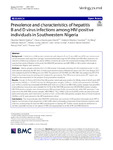Prevalence and characteristics of hepatitis B and D virus infections among HIV-positive individuals in Southwestern Nigeria
Opaleye, Oluyinka Oladele
Akanbi, Olusola Anuoluwapo
Osundare, Folakemi Abiodun
Wang, Bo
Adesina, Olufisayo
Sunday, Sola Thomas
Akindele, Abiodun Akeem
Klink, Patrycja
Bock, C. Thomas
Background
Coinfections of HIV-positive individuals with Hepatitis B and D virus (HBV and HDV) are common and can be associated with rapid liver damage. Several antiretroviral drugs for HIV exhibit anti-HBV effect; however, the selection of HBV drug resistance mutations (DRMs) in individuals under HIV antiretroviral therapy (ART) has been reported but rarely in Nigeria. In this study the HBV/HDV prevalence and HBV DRMs in HIV-positive individuals in Southwestern Nigeria were assessed.
Methods
Plasma samples collected from 310 HIV-positive individuals including 295 ART-experienced and 15 ART-naïve persons attending the HIV clinic in three south-western states of Nigeria between June 2017 and August 2017 were analysed by ELISA for HBsAg and anti-HDV. The presence of HDV RNA and HBV DNA was analysed by (RT)-PCR followed by sequencing and phylogenetic analyses for genotyping. The HBV reverse transcription (RT) region was amplified and sequenced for the analysis of drug resistance mutations.
Results
Overall, 16.1% (n = 50/310) of the HIV-positive individuals were positive for HBsAg, most of which were ART-experienced (94.0%; n = 47/50). From the 50 HBsAg-positive samples, 72.0% (n = 36/50) were positive for HBV DNA and 16.0% (n = 8/50) had detectable HDV RNA while 5.6% (n = 2/36) of the HBV-DNA positive samples had anti-HDV total antibodies. Sequences were available for 31/36 of the HBV DNA-positive and 3/8 HDV RNA-positive samples. HBV DNA-positive samples were characterised as HBV genotype E infections exclusively, while HDV genotype 1 was detected in the HDV RNA-positive samples. HBV DRMs V173L, L180M, S202I and M204V/I, which are associated with lamivudine resistance, were detected in 32.2% (n = 10/31) of the HBV DNA-positive samples. Most of these mutations (90.0%; n = 9/10) were present in the ART-experienced cohort.
Conclusions
This study indicates that HBV/HDV coinfections are common in HIV-positive individuals under ART in Nigeria. Furthermore, a high proportion of HBV DRMs which potentially compromise future treatment options were detected, underscoring the need for HBV screening prior to starting ART. Further studies should be performed to monitor a possible increase in the spread of HDV among populations at risk of HIV and HBV infections.

